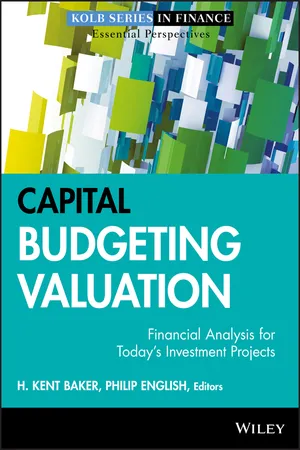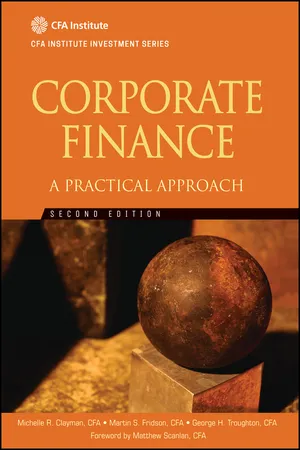Business
Capital Rationing
Capital rationing refers to the situation where a company has limited funds available for investment in various projects. As a result, the company must prioritize and allocate its capital to the most promising projects. This process involves evaluating and selecting projects based on their potential returns and the available budget. Capital rationing helps businesses make strategic investment decisions within their financial constraints.
Written by Perlego with AI-assistance
Related key terms
Related key terms
1 of 4
Related key terms
1 of 3
7 Key excerpts on "Capital Rationing"
- eBook - ePub
Entrepreneurial Finance
Fundamentals of Financial Planning and Management for Small Business
- M. J. Alhabeeb(Author)
- 2014(Publication Date)
- Wiley(Publisher)
Usually, there is a certain limit to a firm's capacity for financing all its available feasible projects. The senior management of firms may fix a limit and determine the maximum capacity of capital investment, and decide whether project financing should be done by borrowing from banks and financial institutions or from the public in terms of corporate bonds and equity shares. Declaring and recognizing the limit on investment may mean recognizing some sort of capital scarcity which should most likely lead to seeking allocation efficiency and that is what is called Capital Rationing. Capital Rationing is defined as the process of allocating scarce financial capital as efficiently as the firm's conditions and circumstances permit. It is obvious that Capital Rationing would be exercised when the total funds requested to finance all eligible projects exceeds the firm's affordability as set by the maximum level of funding. Capital Rationing involves contemplating every possible combination of projects that can be funded, and choosing the best combination of projects, where their total required capital would not exceed the firm's maximum level of funding; their total NPV per dollar is the largest among the alternative combinations. Tables 13.9 and 13.10 show how Capital Rationing is done. Table 13.9 shows five competing projects all of which were considered worthy, but the firm cannot fund all because the required total capital is $300,000 and the firm's maximum level of funding is $200,000. Table 13.10 lists the possible combinations of projects with their combined capital and combined NPV. It also lists the remaining funds out of the available $200,000 (Column 4) and their compounded future values (Column 5). Column 6 shows the sum of NPV and the accumulated future value, and finally Column 7 shows the adjusted NPV per dollar of funded capital. This is the column that shows which combination of projects is the best based on the highest adjusted NPV per dollar - eBook - ePub
Capital Budgeting Valuation
Financial Analysis for Today's Investment Projects
- H. Kent Baker, Philip English, H. Kent Baker, Philip English(Authors)
- 2011(Publication Date)
- Wiley(Publisher)
Much empirical evidence shows that managers prefer to control more assets rather than fewer assets (Stein, 1997). Schumpeter (1934) already recognized that managers have a tendency to build empires and that such empires are not necessarily the result of efficient capital allocation but can harm investor value. Controlling more assets, however, does not mean that the firm uses these assets economically. A consequence of this empire-building behavior is that managers tend to overinvest in projects to increase the “empire” that they control. Agency costs due to overinvestment are actually opportunity costs. Instead of increasing the empire of a particular manager, the firm could have invested funds in projects with a higher return elsewhere or could have paid out dividends to shareholders or repurchased shares if no economically beneficial projects were available. With competition for capital, different investment projects compete for capital and the firm will not fund projects with relatively low expected returns. This mechanism is a form of “winner-picking,” where the firm funds only a fraction of projects based on a relative ranking. Capital Rationing is thus a response to the problem of overinvestment (Holmström and Ricart i Costa, 1986).Understating Future Performance
Understating expected returns is a way of reducing future performance targets for managers. Setting performance targets below what is actually possible, however, could lead to severe misallocations of resources in firms, which result in agency costs. Competitive Capital Rationing is an effective mechanism to address this problem because a firm funds only the highest ranked projects. Competitive Capital Rationing can be a helpful mechanism in capital budgeting because it provides incentives for agents to predict higher returns for their projects. Managers are less inclined to understate expected returns for reasons of lower future performance targets. Capital Rationing thus provides a countervailing force against this tendency (Zhang, 1997; Fisher et al., 2002). Also, to the extent that control mechanisms limit the divergence between managers’ predictions and reality, pressure to predict higher returns provides an incentive to discover new business opportunities with genuinely higher expected returns (Inderst and Laux, 2005). For example, divisions of the company in Exhibit 6.1 - eBook - ePub
The Capital Budgeting Decision
Economic Analysis of Investment Projects
- Harold Bierman, Jr., Seymour Smidt(Authors)
- 2012(Publication Date)
- Routledge(Publisher)
Chapter 6Capital Budgeting Under Capital Rationing
In practice we have tacitly agreed, as a rule, to fall back on what is, in truth, a convention. The essence of this convention – though it does not, of course, work out quite so simply – lies in assuming that the existing state of affairs will continue indefinitely, except insofar as we have specific reasons to expect a change.J. M. KeynesIn the preceding chapters we concluded that, under conditions of certainty, if a firm could borrow or lend funds at a given market rate of interest, it should accept independent investments when the investments have positive net present values at this market rate of interest. In this chapter we consider situations in which the assumption that a firm can borrow or lend any quantity of funds that it desires at a given market rate of interest is not valid. There are two distinctly different Capital Rationing situations in which this assumption may not hold. We assume away the problem of projects and firms having different risks.One of these capital-rationing situations arises because of a decision by management either to limit arbitrarily the total amount invested or the kind of investments the firm undertakes or to set acceptance criteria that lead it to reject some investments that are advantageous when judged by market criteria. For Example, instead of using the market interest rate, the firm might use some higher rate as a cutoff or hurdle rate.A second capital-rationing situation that must be considered is when there is a difference between the market rate of interest at which the firm can borrow money and the market rate at which it can lend.Both situations are frequently labeled Capital Rationing. To distinguish between them, we shall refer to the former situation as internal Capital Rationing and to the latter as external Capital Rationing - eBook - ePub
Corporate Finance
A Practical Approach
- Michelle R. Clayman, Martin S. Fridson, George H. Troughton(Authors)
- 2012(Publication Date)
- Wiley(Publisher)
When the analyst has a fixed budget, the PI is especially useful because it shows the profitability of each investment per currency unit invested. If we rank these projects by their PIs, Projects 5, 6, and 7 are the best projects and we are able to select them. This selection results in a total NPV of $440. The IRRs, shown in the last column, are not a reliable guide to choosing projects under Capital Rationing because a high-IRR project may have a low NPV. Wealth maximization is best guided by the NPV criterion.A third case exists in which the company has more profitable projects than it can choose, but it is not able to invest in the most profitable ones available. Assume the company cannot invest in fractional projects: It must take all or none of each project it chooses. Continuing with the $1,000 capital budget, this case is illustrated in Exhibit 2-27 .EXHIBIT 2-27 Third Capital Rationing ExampleIn this example, an unlimited budget of $1,800 would generate a total NPV of $750. However, when the budget constraint is imposed, the highest NPV results from choosing Projects 9 and 12. The company is forced to choose its best project and its fourth-best project, as indicated by their relative PIs. Any other combination of projects either violates the budget or has a lower total NPV.Capital Rationing has the potential to misallocate resources. Capital markets are supposed to allocate funds to their highest and best uses, with the opportunity cost of funds (used as the discount rate for NPVs or the hurdle rate for IRRs) guiding this allocation process. Capital Rationing violates market efficiency if society’s resources are not allocated where they will generate the best returns. Companies that use Capital Rationing may be doing either “hard” or “soft” Capital Rationing. Under hard Capital Rationing, the budget is fixed and the managers cannot go beyond it. Under soft Capital Rationing, managers may be allowed to over-spend their budgets if they argue effectively that the additional funds will be deployed profitably.In the case of hard rationing, choosing the optimal projects that fit within the budget and maximize the NPV of the company can be computationally intensive. Sometimes, managers use estimates and trial and error to find the optimal set of projects. The PI can be used as a guide in this trial and error process. Other times, the number of possibilities is so daunting that mathematical programming algorithms are used. - eBook - ePub
- (Author)
- 2021(Publication Date)
- Wiley(Publisher)
Given these two approaches to comparing replacement chains, which one should the analyst use? As a practical matter, the two approaches are logically equivalent and will result in the same decision. More specifically, the NPVs of a replacement chain over the least common multiple of lives (six years) were $72.59 for Project S and $62.45 for Project L. If we discount the EAA for Project S ($16.66) and the EAA for Project L ($14.34) for six years (treating each as a six-year annuity), we find the same NPVs. Hence, the least common multiple of lives and EAA approaches are consistent with each other. Consequently, the analyst can choose one approach over the other based on personal preference. Or, if the audience for the analyst’s work prefers to see the analysis using one approach, the analyst can simply produce the analysis in that format.4.2 . Capital Rationing
When a company’s capital budget has a size constraint, a Capital Rationing approach is needed. For example, the capital budget is a fixed money amount. A fixed capital budget can place the company in several interesting situations. To illustrate these, we will assume that the company has a fixed $1,000 capital budget and has the opportunity to invest in four projects. The projects are of variable profitability.In the first situation, the budget is adequate to invest in all profitable projects. Consider the four projects in Exhibit 6 .Exhibit 6. First Capital Rationing ExampleInvestment Outlay NPV PI IRR (%) Project 1 600 220 1.37 15 Project 2 200 70 1.35 16 Project 3 200 −60 0.70 10 Project 4 400 −100 0.75 8 In this case, the company has two positive-NPV projects, Projects 1 and 2, which involve a total outlay of $800. Their total NPV is $290. The Profitability Index (PI) for each project − or ratio of the present value of future cash flows to initial investment − is 1.37 and 1.35 respectively. The company should choose these projects, and it will have $200 in its capital budget left over. These excess funds can be used elsewhere in the company (moved to someone else’s budget, used to pay dividends or repurchase shares, or used to pay down debt). If a manager is afraid to return the excess funds and chooses to invest in Project 3, the manager will consume the whole capital budget but reduce the total NPV to $230, essentially destroying $60 of wealth for the company. - eBook - ePub
Financial Strategies and Topics in Finance
Selected Public Lectures of Professor Harold Bierman, Jr. from 1960–2015
- Harold Bierman Jr(Author)
- 2017(Publication Date)
- WSPC(Publisher)
Lecture 28
Management of Risk and Capital Budgeting
This is one of only a few talks that were fully written out. The talk was given in 1992 at the Johnson School.After the management of a firm has completed its planning process, the resulting long range strategic plan has to be translated into a specific plan of action which actually allocates resources. I will call the specific plan to allocate resources the capital budget and capital budgeting is the process of arriving at the plan.It is convenient to divide investments into two general classifications. First we classify all investment opportunities that are economically independent of each other. Thus an automobile manufacturer might consider replacing its automobile production line with a more labor efficient set of machines, or it might consider entering the airline industry. These are two independent investment alternatives. They compete for financial resources, but their cash flows are economically independent.Once we have determined the independent investments we must next consider all investments which perform the same economic function, where only one investment will be accepted. These are “mutually exclusive” investments.The objective of the capital budgeting process is to make accept or reject decisions involving independent investments (we can undertake all independent investments that are desirable) and “best of the set” decisions involving mutually exclusive investments (we can undertake only one of the mutually exclusive investments). In making these investment decisions there is implied some known and agreed upon objective for the firm.As a first step we should clearly indicate the corporate objectives that are not affecting the capital budgeting process. We are not attempting to maximize total sales or percentage share of market. Growth is not the goal (though growth might occur if the correct decisions are made) nor are earnings per share and total earnings being maximized. The goal is to maximize the risk adjusted net present value of the stockholders’ position and we assume that in doing so we are maximizing the well-being of the stockholders. The decisions are being made from the point of view of the stockholders and it is assumed that their interests are best served by a procedure that systematically assigns a cost to the capital that is utilized in the production process. - eBook - ePub
- Jae K. Shim, Joel G. Siegel, Allison I. Shim(Authors)
- 2011(Publication Date)
- Wiley(Publisher)
Chapter 20 Capital Budgeting Selecting the Optimum Long-Term Investment and Real OptionsCapital budgeting relates to planning for the best selection and financing of long-term investment proposals. Capital budgeting decisions are not equally essential to all companies. The relative importance of this function varies with company size, the nature of the industry, and the growth rate of the firm. As a business expands, problems regarding long-range investment proposals become more important. Strategic capital budgeting decisions can turn the tide for a company.The types of scarce resources that may be committed to a project include cash, time of key personnel, machine hours, and floor space in a factory. When estimating costs for a proposed project, the allocation of the company's scarce resources must be converted into terms of money.The two broad categories of capital budgeting decisions are screening decisions and preference decisions. Screening decisions relate to whether a proposed project satisfies some current acceptance standard. For instance, a company may have a policy of accepting cost reduction projects only if they provide a return of at least 15 percent.Preference decisions apply to selecting from competing courses of action. For example, a company may be looking at four different manufacturing machines to replace an existing one. The selection of the best machine is referred to as a preference decision.The basic types of investment decisions involve selections between proposed projects and replacement decisions. Selection requires judgments concerning future events of which one has no direct knowledge. One has to consider timing and risk. The task is to minimize chances of being wrong. To help deal with uncertainty, one may use the risk-return trade-off method. Discounted cash flow methods are more realistic than methods that do not take into account the time value of money in appraising investments, particularly in inflationary periods.
Index pages curate the most relevant extracts from our library of academic textbooks. They’ve been created using an in-house natural language model (NLM), each adding context and meaning to key research topics.
Explore more topic indexes
Explore more topic indexes
1 of 6
Explore more topic indexes
1 of 4






